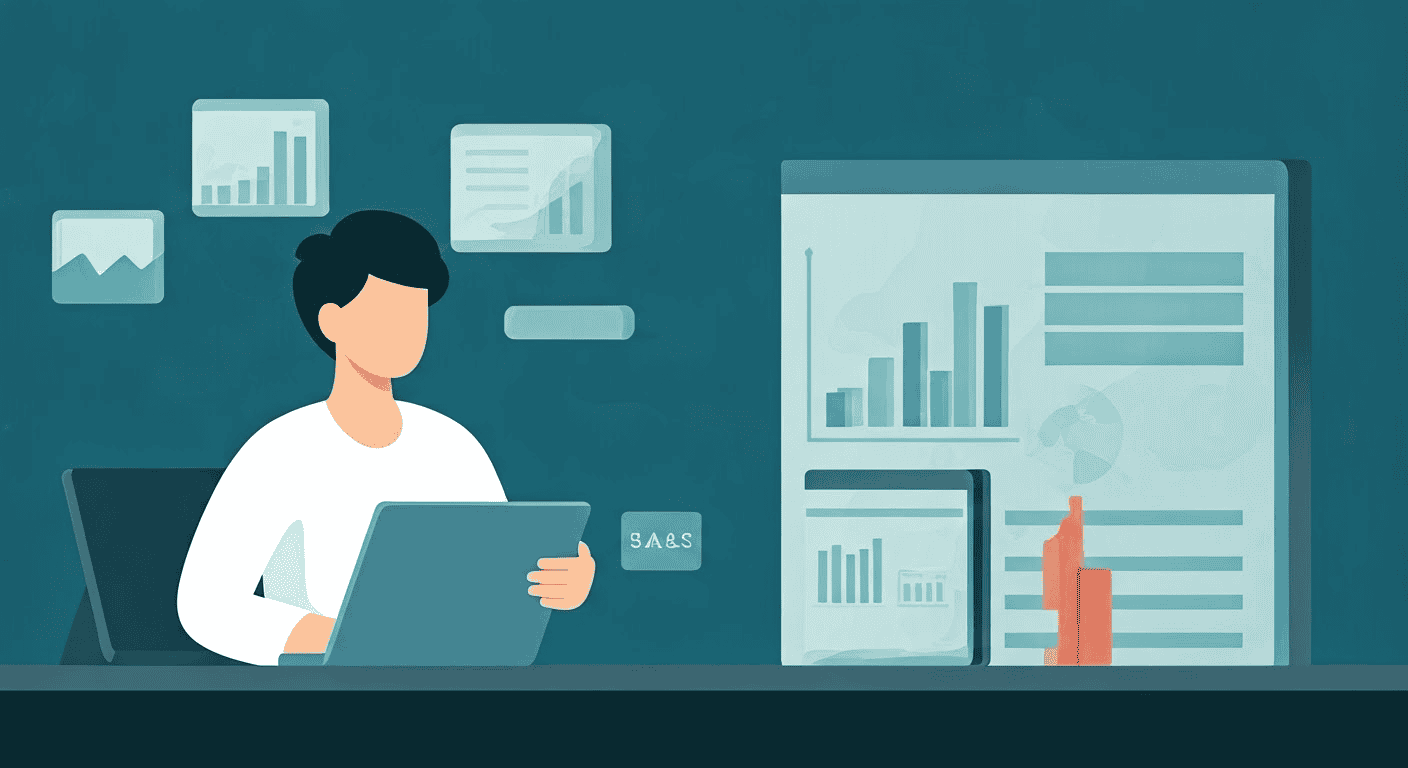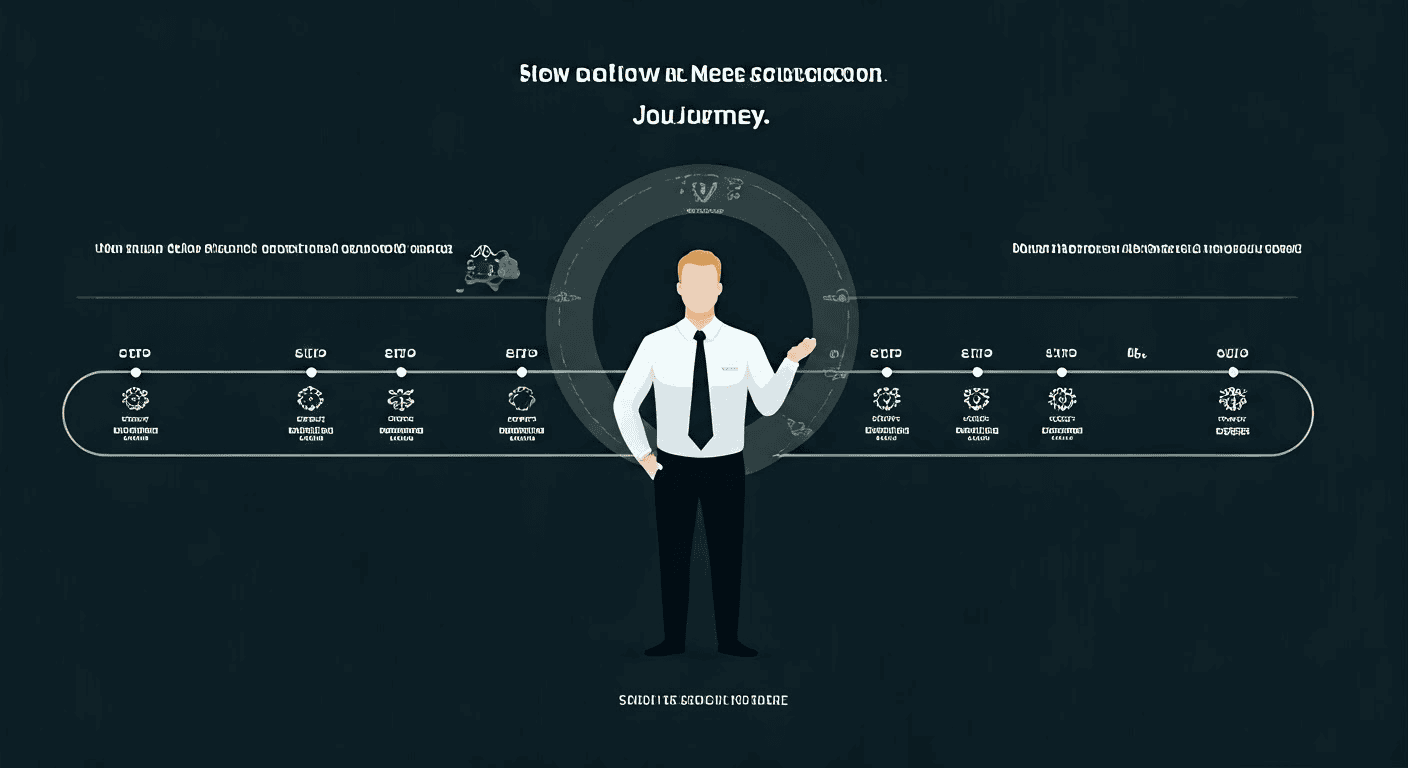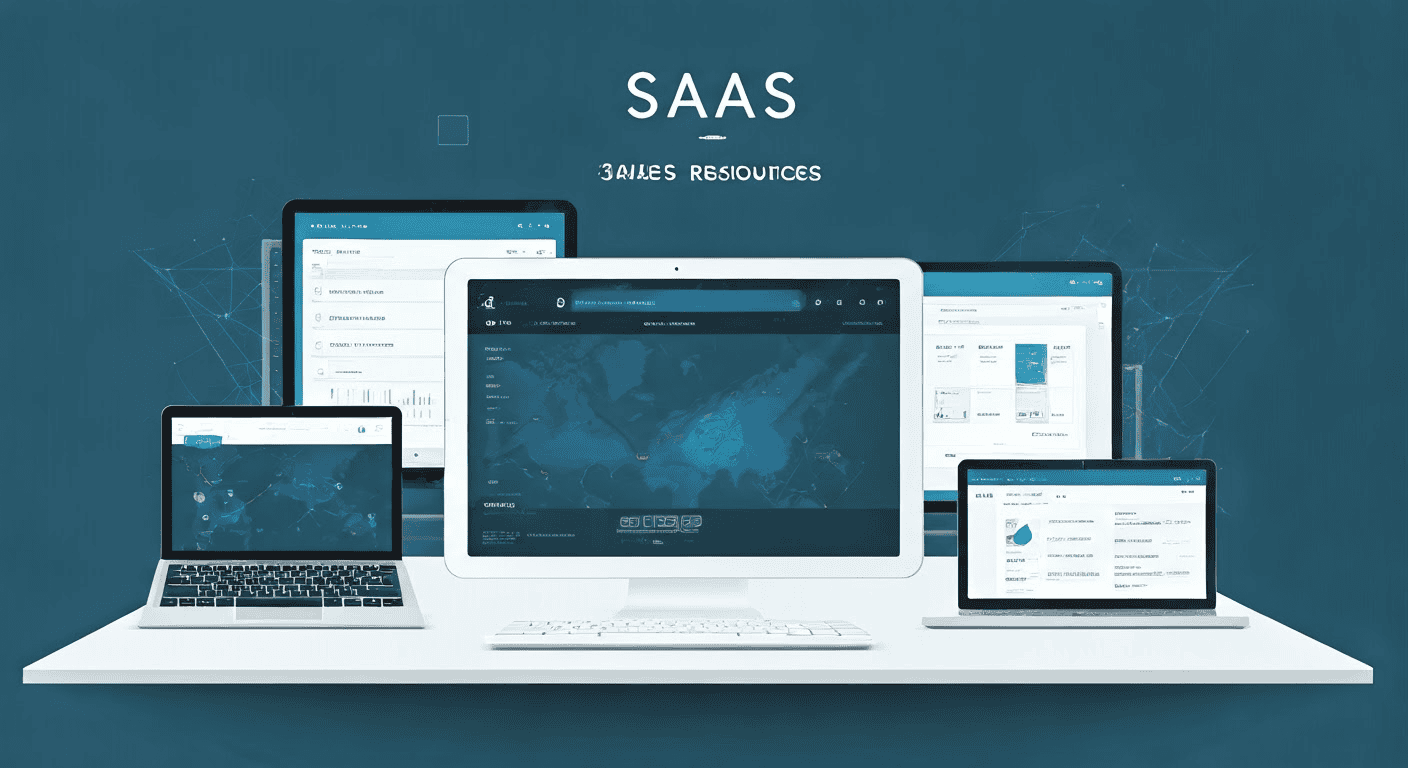Key Highlights
What strategies are effective for selling SaaS products?
- This guide is your roadmap to navigating the world of SaaS sales, tailored specifically for Account Executives (AEs) in their first year.
- We’ll cover the fundamentals of the SaaS sales process, equipping you with the knowledge and strategies to excel from day one.
- You will understand key challenges and how to overcome them, including handling rejection, mastering time management, and continuously refining your approach.
- This guide provides insights into advanced techniques such as data-driven selling and social selling to give you an edge in the competitive SaaS market.
- Whether you’re just starting your SaaS sales journey or looking to solidify your foundations, this guide has something for you.
Introduction
Starting your first year as an Account Executive (AE) in the fast-paced SaaS industry can be exciting but also tough! This guide will give you the tools and ideas you need to do well in the SaaS sales process. We will share helpful tips, methods, and real examples to help you manage the special challenges of SaaS sales. By learning these strategies, you can meet your goals. You will also build great customer relationships and start a successful career in SaaS sales.
Understanding the SaaS Sales Landscape

SaaS is different from traditional software sales. While traditional sales can be one-time purchases, SaaS works on a subscription basis. This way of earning money is very important for SaaS companies. It gives them steady income, but they must also keep customers happy and engaged.
To do well in SaaS sales, you need to understand this difference. You should focus on building long-term relationships and showing long-term value to your customers. The SaaS market is always changing, so sales professionals must be flexible and ready for new trends.
The Evolution of SaaS Sales
The SaaS industry has changed a lot over the years. It has moved from simple software to more complex solutions. This change has affected how SaaS companies operate and how they make sales.
In the beginning, sales were mainly based on a transactional sales model. Businesses focused on closing deals quickly and getting new customers. As the market grew and competition increased, a customer-focused way of selling became more important.
Now, SaaS sales focus on building long-term relationships with customers, including providing excellent customer support. They aim to understand what customers need, provide great service, and offer ongoing value. Successful SaaS companies know that keeping existing customers is cheaper than always trying to find new customers.
Key Challenges for New AEs in SaaS
As a new AE, you will face some special challenges in the SaaS world. One big challenge is understanding the product and what makes it valuable. SaaS solutions can be complex. You need to know them well to explain their benefits to potential customers.
Another challenge is dealing with the longer sales cycles common in SaaS, especially for products with a higher price point. Unlike regular software sales, closing deals can take time. This is especially true for enterprise-level clients. Here, many people must agree on the decision.
Finally, many SaaS products have higher prices. This can make it hard to handle objections and get prospects to sign up. You need to clearly explain the return on investment (ROI) and show the long-term value your solution can provide.
Laying the Foundation: Preparing for Success in SaaS Sales

Now that we have talked about the changing SaaS world and the problems you could face, let’s focus on how to ensure your success. Being prepared is very important in any sales job. It is even more crucial in the quick-moving SaaS market.
This means you need to learn the right skills, build a solid knowledge base, and know the best practices in the industry. By spending time now to improve your foundation, you will be ready to meet the demands of SaaS sales. This will help you get good results consistently.
Essential Skills and Tools for SaaS Sales Success
Thriving in SaaS needs strong sales skills and good sales enablement tools. Here are some important skills to work on:
- Active Listening: It is vital to understand what customers need in SaaS sales. Work on listening carefully, asking smart questions, and finding their pain points.
- Product Knowledge: Know your SaaS product very well. This will help you become a trusted adviser. You should be able to explain its features, benefits, and how it can be used clearly.
- Communication Skills: Share complex information simply and effectively. Do this both in speech and writing.
- Objection Handling: Be ready to respond to concerns from prospects. Give informed replies that can turn objections into chances to highlight your value.
- Closing Techniques: Learn different closing methods. This will help you guide prospects in deciding to buy. It will also help you close deals better and increase your conversion rates.
By building these key skills, you can do well in the SaaS sales world and achieve great results.
Building a Strong Knowledge Base on SaaS Products
Positioning yourself as a trusted advisor to your customers begins with having strong product knowledge. In SaaS, it is important to go beyond just a basic understanding. You need to take the time to learn the details of your product.
Start by knowing the key features and functions of your SaaS business product. Learn how each feature helps with specific customer needs and pain points. Look into various use cases and success stories. Share how your product has helped businesses that are similar to those you want to reach.
When you become an expert on your product, you can easily answer customer questions. You can also deal with objections and show how your solution can tackle their unique challenges. This skill builds your credibility and creates trust, which can help you close more deals.
Getting Started: What You Need

With a strong base set, you can now focus on the hands-on parts of your SaaS sales job. This step means finding your best customers, building a strong sales toolkit, and staying organized.
It’s important to know who you want to sell to and what tools can help you reach them, including cold calls. These first steps are key to boosting your productivity and making sure you attract and keep the right prospects.
Identifying Target Markets and Customer Personas
In the world of SaaS, it is very important to know your target market and your ideal customer. This helps you focus on reaching the businesses that can really benefit from your SaaS product.
Customer personas help you understand your ideal buyers even better. They provide detailed information about:
- Demographics: This includes things like company size, industry, and location.
- Psychographics: This covers their goals, challenges, pain points, and motivations.
- Behavioral Patterns: This looks at how they make decisions, where they get information, and how they buy.
By clearly defining your ideal customer profile, you can customize your sales pitch, messaging, and marketing strategies. This will help you connect better with potential customers and turn them into loyal ones.
Setting Up Your SaaS Sales Toolkit
Equipping yourself with the right sales tools is very important for efficiency and success. A good toolkit helps you manage your prospects better, organize your tasks, and boost your output. Here are some must-have tools that offer customization options to think about:
- CRM Systems: A Customer Relationship Management (CRM) system helps you keep all customer interactions in one place. It tracks leads, communication history, and how far your deals have come.
- Sales Intelligence Tools: These tools give you important information about your prospects and their businesses. This helps you personalize your approach and adjust your messages better.
- Automation Tools: These tools help you with repetitive tasks, care for leads, and give you more time for important activities like building relationships and making sales.
By using technology and putting together a solid sales toolkit, you can manage your sales pipeline well. This will help you work better and increase your chances of closing deals. Use these tools as helpful partners in your SaaS sales path.
Step-by-Step Guide to Your First Year as a SaaS AE

To have a strong start in your first year as a SaaS Account Executive, you need to know some practical steps. This guide will give you clear actions and strategies for every part of the sales process.
Consistency and learning every day are very important for your success in SaaS sales. Enjoy the challenges, ask for help from mentors, and always work on improving your methods.
Step 1: Understanding Your SaaS Offering Inside and Out
Your SaaS journey starts with knowing your product well. Don’t just learn the features; understand how they are helpful and solve real problems. The best way to practice giving great product demos is to ensure these demos show what the solution can do and how it can help with specific pain points for customers.
Remember, you are not just selling a product. You are selling an experience. It’s important to understand the customer’s sales experience journey. This starts from the first contact and goes through onboarding and further. Get to know the different points where the customer interacts with your service and how your SaaS product improves their overall experience.
When you become an expert on your product and see how it affects the customer journey, you can share its value better. This builds trust and helps guide potential buyers toward making a decision.
Step 2: Mastering the Art of Prospecting
Prospecting is very important for SaaS sales. It helps bring in leads for your SaaS sales funnel. To be good at prospecting, you need to find, qualify, and talk to potential customers who match your ideal customer profile.
Use different methods to find leads. This can include online sites like LinkedIn, industry events, content marketing, and getting referrals. Remember, personalizing your outreach is very important.
Create messages that speak to their pain points and catch their interest. By improving your prospecting skills and using a solid strategy, you can keep getting qualified leads to fill your sales pipeline.
Step 3: Conducting Effective Sales Demos
A good sales demo is very important to help prospects move down the sales funnel. It’s a chance to show how your SaaS product can help meet their needs. Don’t just list a lot of features.
Instead, use a consultative selling style. Focus on listening actively and ask questions to find out what their pain points are. Then, adapt your demo to fit those needs. Make it clear how your product can solve their problems and the benefits they will get.
Plan your demo in a way that makes sense. Highlight the key features that matter most to your prospect. Talk about the value, return on investment (ROI), and advantages of your solution. Remember, a great sales demo should be engaging, interactive, and create a strong positive impression on your prospect.
Step 4: Navigating Negotiations and Closing Deals
Negotiations are a key part of the sales cycle. As an Account Executive, you must handle this stage well to get deals that help both sides. You need to know your prospect’s budget limits, solve their issues, and find terms that work for everyone.
It’s important to see negotiations with a win-win mindset. Don’t think of it as a fight. Instead, look for ways to meet your prospect’s needs while taking care of your company’s goals. By asking the right questions, listening closely, and understanding what matters to them, you can find common ground and reach an agreement that works for both.
Keep in mind that closing a deal is not the end of the journey in SaaS sales. It’s just the start of a long-lasting relationship with your customer.
Step 5: Managing Post-Sale Relationships and Upselling
In SaaS, the sales cycle doesn’t end when you close the first deal. It’s important to build good relationships with your customers after the sale. This can help you keep customers loyal, create chances to sell more, increase customer lifetime value, and get helpful referrals.
Once a deal is done, make sure to start good onboarding. This will help customers understand the value of your SaaS product quickly. By taking care of the relationship and solving any issues fast, you’ll show that you care about their success. This way, you’ll turn them into advocates for your brand inside their company.
As you keep building these relationships, you can find chances to upsell and cross-sell. By knowing their changing needs and offering them more solutions, you can make their experience better and grow your business.
Overcoming Common First-Year Challenges

Your first year as an Account Executive (AE) will have its ups and downs. You will face challenges. It is important to see these as chances to grow and improve. If you learn about common mistakes and use good strategies to get past them, you will become a stronger and successful SaaS sales expert.
Here are some challenges you may face and tips for tackling them directly.
Handling Rejection and Learning from Losses
Rejection is a common part of sales. In SaaS, sales can take a long time. It’s important to be strong and not take rejection to heart. Understand that not every potential customer will become one. Look at these moments as chances to learn and grow.
When you lose a deal, analyze what happened. Were there common reasons why the customer said no? Did you make mistakes in how you sold?
By finding out why deals were lost, you can improve your approach. You can make your sales pitch better and increase your chances of success next time. Remember, every “no” gets you closer to a “yes.”
Time Management and Prioritization Tips for AEs
As a sales rep, your time is very important. It’s key to manage your time well and focus on tasks that matter. This helps you stay organized, boost your productivity, and reach your sales goals. Start by making a schedule. This will give you specific blocks of time for important activities.
Focus on tasks that help you close deals, like reaching out to potential clients, giving demos, and following up. Use tools that help with your work, like CRM systems, calendar apps, and task management software. These can make your tasks easier to handle.
Keep in mind that managing your time well takes practice. You need discipline and to improve your methods over time. By regularly checking your tasks and adjusting them, you’ll use your time wisely and set yourself up to succeed.
Advanced Techniques for the Ambitious AE

For Account Executives who want to stand out, using advanced methods in your sales strategy can give you an edge over others. These methods focus on working smarter instead of just putting in more effort. By using data and insights, you can improve your approach and have a bigger impact.
Now, let’s look at two strong techniques: data analytics and social selling.
Leveraging Data Analytics for Strategic Selling
In today’s world, using analytics is very important for success in SaaS sales. Data insights give us useful information about our potential customers, how they act, and how well our sales strategies are working. By using data analytics, we can make smart choices, tailor our outreach, and improve our methods for better results.
Start by keeping an eye on important sales metrics. Look at things like conversion rates, customer acquisition costs, and customer lifetime value. Analyze these metrics to find trends, patterns, and areas that need improvement. For instance, if you see that a certain stage in your sales funnel has a low conversion rate, you can change your approach and messaging to fix the issue.
By adopting a data-driven mindset and using data insights, we can keep improving our sales process. This helps us make better choices and reach our targets more easily.
Incorporating Social Selling into Your Strategy
Social selling is now a key part of sales strategies, supported by your marketing team. It helps you connect with prospects, build relationships, and get leads. This process uses social media platforms to engage with potential customers. You can share useful content and show that you are a trusted expert in your field.
To get started, figure out which social media platforms your target audience uses the most. Then, adjust your content to fit their interests. Offer insights, articles, and useful news that could help your prospects. Interact with their posts, reply to comments, and join conversations that matter to them. This will help you build trust and strengthen your relationships.
Keep in mind that social selling isn’t about pushing your product hard. It’s about offering value, making connections, and nurturing bonds over time. By adding social selling to your sales strategies, you can reach more people, find qualified leads, and improve your sales results.
Building and Scaling Your SaaS Sales Process
As you gain experience and have steady success, you will want to create a strong SaaS sales model and process. This process should give reliable results every time. Making a system that works over and over is not about being strict. It is about creating a setup that can change and grow with your business.
This means you need to simplify your worksteps, use technology, and set clear processes. These processes should be easy to follow as your team gets bigger.
Crafting a Repeatable Sales Cycle
A repeatable sales cycle is the backbone of a scalable SaaS sales process. It involves defining the key stages of your sales process and the actions required at each step to move prospects toward a purchase decision.
Here is an example of how to structure and standardize your sales cycle:
| Stage | Action Items |
| Prospecting | Identify and qualify potential customers through research |
| Connecting | Reach out to leads and schedule meetings or calls |
| Qualifying | Determine if the lead is a good fit and has a need for your product |
| Demonstrating | Showcase the product’s value and address specific needs. |
| Closing | Negotiate terms and secure a commitment from the prospect. |
| Onboarding | Ensure a smooth transition for new customers |
By documenting your sales cycle and creating a repeatable process, you establish a consistent framework that can be measured, analyzed, and optimized over time.
Essential Metrics for Tracking Success
Tracking key performance indicators (KPIs) is important to see how well your sales are doing. In SaaS, there are many metrics that can help you understand your progress and where you can get better. It’s important to focus on the metrics that fit your goals.
Here are some key metrics to watch:
- Monthly Recurring Revenue (MRR): This tells you how much money you earn from subscriptions each month. It helps you see how healthy your business is.
- Churn Rate: This shows the percentage of customers who cancel their subscriptions over time. It can point out where you need to keep customers better.
- Customer Acquisition Cost (CAC): This figure shows how much it costs to get a new customer. It helps you evaluate how well your marketing and sales are working.
- Customer Lifetime Value (CLTV): This metric estimates how much money a customer will bring in during their time with your company. It guides your long-term plans.
By keeping an eye on these metrics regularly, you can spot areas that need work. This way, you can make smart choices to improve your sales process.
SaaS Sales Resources and Tools

In the fast-moving world of SaaS sales, it is important to keep learning. You need to find new knowledge, insights, and tools to stay successful. Good resources can help you improve your skills, better your strategies, and adjust to the changing industry.
Let’s look at some useful resources and tools that will make your SaaS sales journey better.
CRM Systems and Their Importance
Customer Relationship Management (CRM) systems are now essential for every SaaS sales team. They act as a main hub to manage customer data, track interactions, and smoothen the sales process. With CRMs, you can manage leads well, see how they move through the sales pipeline, and understand customer behavior better.
By bringing customer information together, CRMs help team members work better. It means everyone can see the latest information. This real-time view improves how sales, marketing, and customer success teams talk and coordinate. As a result, it creates a better experience for customers during their journey.
Also, CRM systems give important reports and analytics. These insights show sales performance, conversion rates, and how engaged customers are. This data-driven way helps sales managers make smart choices, spot where they can improve, and fine-tune their strategies.
Automation Tools to Enhance Productivity
In the sales world, efficiency is very important. Automation has become a big help. It takes care of repetitive tasks and makes workflows easier. This lets sales teams focus on what really counts: building relationships and closing deals. Sales automation tools help with many tasks. They assist with lead nurturing emails, scheduling appointments, and managing tasks.
By automating follow-ups, sales reps make sure that leads get the attention they need. This way, they don’t miss any good chances. Automation helps make the sales process smoother, boosts productivity, and improves the customer experience.
Use automation as your partner in the tough SaaS market. It helps you save time and mental energy so you can focus on important tasks that help grow your revenue.
Creating a Sustainable Career in SaaS Sales
Building a successful career in SaaS sales is more than just meeting goals. It is about developing important skills, always learning, and expanding your professional network. By focusing on these habits, you can stay flexible and relevant in this fast-changing industry.
Make your professional growth a top priority. The skills and knowledge you have now might not be enough in the future, so being adaptable is very important in this changing world.
Continuous Learning and Skill Development
In the fast-changing world of SaaS, learning continuously is very important for a successful career. The industry keeps changing with new technologies, updated sales strategies, and different customer needs. Embrace a growth mindset. Look for chances to learn more and improve your skills.
Stay informed about new trends by reading blogs, articles, and books by top SaaS sales experts. Join webinars and workshops to hear new ideas and learn from other people’s experiences. Don’t be shy about finding mentors in your company or field who can offer help and advice.
When you make continuous learning a priority, you will stay ahead of the rest. This will show your dedication to growing professionally, which makes you a valuable part of any SaaS company.
Networking and Building Industry Connections
Networking is very important for growing your career and developing your business in the SaaS industry. Strong relationships with other professionals, potential clients, and industry experts can lead to new chances, helpful insights, and better success.
Make sure to attend industry events, conferences, and meetups. These are great places to meet people with similar interests, share ideas, and learn about new trends. Connecting with peers, mentors, and potential clients will help you build your network and keep you updated on what’s happening in the SaaS world.
Building strong connections in the industry can give you new viewpoints, possible partnerships, and useful leads. It is not only about what you know but also about who you know. This can really change the path of your career in this fast-changing industry.
Conclusion
In conclusion, getting into a SaaS sales career means you need to think carefully and keep learning. As a new Account Executive, it is important to learn key skills. You should know your product well and improve your prospecting and negotiation skills to be successful. Remember, facing challenges like rejection and managing your time is part of the learning process. Using data analytics, social selling, and automation tools can help your sales process. Stay active, check your progress with important metrics, and focus on building strong customer relationships. By working on your skills and making industry connections, you can create a lasting and rewarding career in SaaS sales.
Frequently Asked Questions
What are the most effective SaaS sales strategies for new AEs?
- New AEs should learn the sales cycle well.
- They need to know about customer acquisition cost.
- Excellent customer service is important.
- They should also work on improving their sales skills all the time.
How can I quickly learn about my company’s SaaS product?
- Use sales enablement resources.
- Join product demos.
- Try free trials.
- This will help you get a good understanding of the product.
What are some common pitfalls in the first year of SaaS sales?
Common mistakes include not focusing on keeping customers, misinterpreting the sales model, and having a hard time managing the churn rate.
How do I measure my success as a SaaS AE?
Track your success by looking at important KPIs. These include annual recurring revenue, customer lifetime value, and lead conversion rates.
Can you recommend any books or courses for improving SaaS sales skills?
- Look into sales training programs from trusted institutions.
- Consider reading books like “Predictable Revenue” and “The Sales Acceleration Formula.”
- These can help you with ongoing learning.
